Determination of Injection Parameters using Line Pressure and Solenoid Signals from a Common-Rail Direct Injection Diesel Engine
Abstract
Abstract—The determination of fuel injection parameters is very important in studying diesel engines. Knowing what happens to the fuel as it is being injected onto the engine cylinders may help in understanding the outcome of different engine operations. Fuel injector behavior affects what happens inside the engine cylinders and may help explain fuel consumption, torque and power produced, emission characteristics, and other engine performance metrics. Much attention is given to the operation of diesel engines nowadays brought about by the interest in alternative fuel sources. This study describes a method of estimating actual main injection (excluding pilot injection) parameters: start, end, and duration of injection for a Common-Rail Direct Injection (CRDI) engine based on the information given by the fuel supply line pressure sensor mounted on the tubing that connects the fuel injector to the common rail. The timing of the fuel supply line pressure signal was compared to that of the associated Electronic Control Unit (ECU) injection command signal to validate a sensible phase relationship. Distinct shape characteristics of the line pressure signal were identified and considered as start and end of actual main fuel injection. The estimation method was used to determine fuel injection behavior of a CRDI engine running at full load from 800 to 4000 rpm. The study also showed that increasing RPM increases the injection duration, average line pressure and advances the injection timing.
Keywords— CRDI, line pressure, solenoid signal, injection duration


